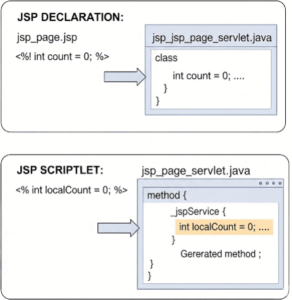JSP Declarations: Declaring Members in JSP Pages
Hello everyone! In the realm of JavaServer Pages, JSP declarations play a crucial role in enabling developers to define class-level members directly within their JSP pages. These declarations allow you to declare variables and methods that belong to the generated Servlet class, providing a powerful mechanism for shared logic and state across multiple client requests. Understanding JSP declarations is key to writing efficient and maintainable JSP applications.
What are JSP Declarations?
JSP declarations are a type of scripting element used to declare variables and methods that become members of the Servlet class generated from the JSP page. Unlike variables declared within scriptlets, which are local to the _jspService() method, JSP declarations are defined at the class level. Consequently, they are initialized only once when the JSP page is loaded, and their state is shared across all client requests to that page. This provides a way to establish persistent data or reusable helper functions.
Syntax and Placement of JSP Declarations
The syntax for JSP declarations is distinct and easily recognizable:
<%!
// Declare variables here
// Declare methods here
%>
The content within the <%! ... %> tags is placed directly into the body of the generated Servlet class, outside of any methods. Therefore, any variable declared here will be an instance variable of the Servlet, and any method will be an instance method. This placement is fundamental to how JSP declarations operate, as it means they are part of the Servlet’s class structure and are not recreated with every request.
Practical Uses of JSP Declarations
JSP declarations offer several practical applications for enhancing JSP pages:
Declaring Instance Variables: You can declare variables that hold state across multiple requests or need to be initialized once. For example, a counter that tracks page views across all users:
Java<%! int pageVisits = 0; %> <% pageVisits++; out.println("Page visited " + pageVisits + " times."); %>Defining Helper Methods: Complex logic that needs to be reused across different parts of the JSP page can be encapsulated in methods declared within
<%! ... %>tags. This promotes code reusability and readability.Java<%! public String getGreeting(String name) { return "Hello, " + name + "!"; } %> <html> <body> <p><%= getGreeting("JSP User") %></p> </body> </html>
When considering whether to use a declaration, think about whether the variable or method needs to be shared across multiple requests or needs to be available to other methods within the generated Servlet class.
JSP Declarations vs. Scriptlets: Key Differences
It’s common for new JSP developers to confuse JSP declarations with scriptlets. However, understanding their differences is vital for correct implementation and managing state effectively. Below is a comparison to clarify these scripting elements:
| Feature | JSP Declarations (<%! ... %>) | Scriptlets (<% ... %>) |
|---|---|---|
| Code Placement | Outside of any method, directly in the generated Servlet class. | Inside the _jspService() method of the generated Servlet class. |
| Scope/Lifecycle | Class-level members. Initialized once when the JSP is loaded. | Method-level (local) variables. Executed with each request. |
| State | Shared state across all client requests to the JSP page. | Local state, recreated for each request. |
| Usage | Declaring methods and instance variables. | Embedding executable Java code for request-specific logic. |
| Thread Safety | Requires careful handling for thread safety (e.g., synchronization). | Generally thread-safe for local variables. |

